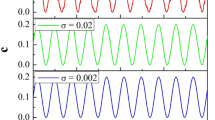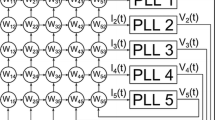Abstract
FitzHugh-Nagumo, FHN, is a most critically significant Neural Cell method which is effectively capable of modeling the synaptic behavior by leveraging van-der-pol oscillators. The FitzHugh-Nagumo model makes use of common circuitry of FHNs, remarkably similar to the very conventional LC oscillators. Conventional LC oscillators, needless to say, have been largely deployed and comprehensively studied for quite some time. Notwithstanding its similarity to other LC oscillators, FitzHugh-Nagumo contains a resistor in series with the circuit that makes it inconsistent with other LC oscillator models. In this paper, a productive circuit technique is used to make FitzHugh-Nagumo circuit analogous to a LC conventional oscillator, which consequently provides the capability of using analytical approaches on these systems. This gives the designer of neural cells the opportunity of taking advantage of the vast knowledge about oscillatory systems. The proposed circuit model has been verified in terms of accuracy and compatibility for free-running, locked, and unlocked states. In addition, a theoretical analysis, aiming to clarify the background principle of the FitzHugh-Nagumo design process, is also provided. The simulation results which are performed using TSMC 180 nm CMOS technology represent a good agreement between theory and simulation.







Similar content being viewed by others
Data availability statement
The datasets generated during and/or analyzed during the current study are available from the corresponding author on reasonable request.
Change history
18 March 2022
The original online version of this article was revised: The university name in the affiliation of the authors has been corrected from 'Tabriz University' to 'University of Tabriz'.
References
Cosp, J., Binczak, S., Madrenas, J., & Fernandez, D. (2008). Implementation of compact VLSI FitzHugh-Nagumo neurons. 2008 IEEE international symposium on circuits and systems, pp. 2370–2373.https://doi.org/10.1109/ISCAS.2008.4541931
Koickal, T., Hamilton, A., Pearce, T., Tan, S., & Covington, J. (2006). Analog VLSI design of an adaptive neuromorphic chip for olfactory systems. In Proc. IEEE international symposium on circuits and systems (ISCAS' 06), Island of Kos, Greece, pp. 4547–4550.
Zoua, Q., Bornat, Y., Tomas, J., Renaud, S., & Destexhe, A. (2006). Real-time simulations of networks of hodgkinhuxley neurons using analog circuits. Neurocomputing, 69, 1137–1140.
Horio, Y., Taniguchi, T., & Aihara, K. (2005). An asynchronous spiking chaotic neuron integrated circuit. Neurocomputing, 64, 447–472.
Nakada, K., Asai, T., & Hayashi, H. (2006). Analog VLSI implementation of resonate-and-fire neuron. International Journal of Neural System, 16(6), 445456. Show in Context CrossRef Google Scholar
Linares-Barranco, B., Sánchez-Sinencio, E., Rodríguez- Vázquez, A., & Huertas, J. (1991). A CMOS implementation of fitzhugh-nagumo neuron model. IEEE Journal of Solid-State Circuits, 26(7), 956–965.
Keener, J. P. (1983). Analog circuitry for the van der Pol and FitzHugh-Nagumo equations. IEEE Transactions on Systems, Man, and Cybernetics, 13(5), 1010–1014. https://doi.org/10.1109/TSMC.1983.6313098
Liu, Z., Wang, C., Jin, W., et al. (2019). Capacitor coupling induces synchronization between neural circuits. Nonlinear Dynamics. https://doi.org/10.1007/s11071-019-05155-7
Yang, K. H., Franaszczuk, P. J., & Bergey, G. K. (2003). The influences of somatic and dendritic inhibition on bursting patterns in a neuronal circuit model. Biological Cybernetics, 89(4), 242–253.
Bao, B. C., Wu, P. Y., Bao, H., et al. (2018). Numerical and experimental confirmations of quasi-periodic behavior and chaotic bursting in third-order autonomous memristive oscillator. Chaos, Solitons & Fractals, 106, 161–170.
Hu, X., Liu, C., Liu, L., et al. (2016). An electronic implementation for Morris-Lecar neuron model. Nonlinear Dynamics, 84, 2317–2332.
Ren, G., Xu, Y., & Wang, C. (2017). Synchronization behavior of coupled neuron circuits composed of memristors. Nonlinear Dynamics, 88, 893–901.
Ren, G., Zhou, P., Ma, J., et al. (2017). Dynamical response of electrical activities in digital neuron circuit driven by autapse. International Journal of Bifurcation and Chaos, 27(12), 1750187.
Hodgkin, A., & Huxley, A. (1952). A quantitative description of membrane current and application to conduction and excitation in nerve. Journal of Physiology, 117, 500–544.
Izhikevich, E. (2006). Dynamical systems in neuroscience. The geometry of excitability and bursting. Cambridge, MA: The MIT Press.
Grassia, F., Lévi, T., Tomas, J., Renaud, S., & Saïghi, S. (2011). A neuromimetic spiking neural network for simulating cortical circuits. 2011 45th annual conference on information sciences and systems, pp. 1–6. https://doi.org/10.1109/CISS.2011.5766098.
Chen, C., Wu, H., & Chen, H. (2012). A conductance-based neuronal network in VLSI for studying the CPR circuit of the crayfish. IEEE International Symposium on Circuits and Systems (ISCAS), 2012, 2051–2054. https://doi.org/10.1109/ISCAS.2012.6271685
Yu, T., Sejnowski, T. J., & Cauwenberghs, G. (2011). Biophysical neural spiking, bursting, and excitability dynamics in reconfigurable analog VLSI. IEEE Transactions on Biomedical Circuits and Systems, 5(5), 420–429. https://doi.org/10.1109/TBCAS.2011.2169794
Russell, A., Mazurek, K., Mihalaş, S., Niebur, E., & Etienne-Cummings, R. (2012). Parameter estimation of a spiking silicon neuron. IEEE Transactions on Biomedical Circuits and Systems, 6(2), 133–141. https://doi.org/10.1109/TBCAS.2011.2182650.PMID:23852978;PMCID:PMC3712290
Larras, B., Lahuec, C., Seguin, F., & Arzel, M. (2016). Ultra-low-energy mixed-signal IC implementing encoded neural networks. IEEE Transactions on Circuits and Systems I: Regular Papers, 63(11), 1974–1985. https://doi.org/10.1109/TCSI.2016.2600663
Irizarry-Valle, Y., & Parker, A. C. (2015). An astrocyte neuromorphic circuit that influences neuronal phase synchrony. IEEE Transactions on Biomedical Circuits and Systems, 9(2), 175–187. https://doi.org/10.1109/TBCAS.2015.2417580
Haghiri, S., Ahmadi, A., & Saif, M. (2017). Complete neuron-astrocyte interaction model: Digital multiplierless design and networking mechanism. IEEE Transactions on Biomedical Circuits and Systems, 11(1), 117–127. https://doi.org/10.1109/TBCAS.2016.2583920
Razavi, B. (2004). A study of injection locking and pulling in oscillators. IEEE Journal of Solid-State Circuits, 39(9), 1415–1424.
Lanka, N. R., Patnaik, S. A., & Harjani, R. A. (2011). Frequency-hopped quadrature frequency synthesizer in 0.13-μm technology. IEEE Journal of Solid-State Circuits, 46(9), 2021–2032. https://doi.org/10.1109/JSSC.2011.2139490.
Mirzaei, A., Heidari, M. E., Bagheri, R., Chehrazi, S., & Abidi, A. A. (2007). The quadrature LC oscillator: A complete portrait based on injection locking. IEEE Journal of Solid-State Circuits, 42(9), 1916–1932.
Ali, I., Biswas, B. N., & Ray, S. (2014). Improved closed form large injection perturbation analytical model on the output spectrum of unlocked driven oscillator—Part I: Phase perturbation. IEEE Transactions on Circuits and Systems I: Regular Papers, 61(1), 106–119.
Tofangdarzade, A., Tofangdarzade, A., & Saniei, N. (2018). Strong injection locking and pulling in LC multiphase oscillators with multiple injection signals. IEEE Transactions on Circuits and Systems II: Express Briefs, 66(8), 1336–1340.
Tofangdarzade, A., & Jalali, A. (2015). An efficient method to analyze lock range in ring oscillators with multiple injections. IEEE Transactions on Circuits and Systems II: Express Briefs, 62(11), 1013–1017.
Author information
Authors and Affiliations
Corresponding author
Additional information
Publisher's Note
Springer Nature remains neutral with regard to jurisdictional claims in published maps and institutional affiliations.
Rights and permissions
About this article
Cite this article
Khakipoor, Y., Bahar, H.B. & Karimian, G. An efficient analysis of FitzHugh-Nagumo circuit model. Analog Integr Circ Sig Process 110, 385–393 (2022). https://doi.org/10.1007/s10470-021-01947-3
Received:
Revised:
Accepted:
Published:
Issue Date:
DOI: https://doi.org/10.1007/s10470-021-01947-3




